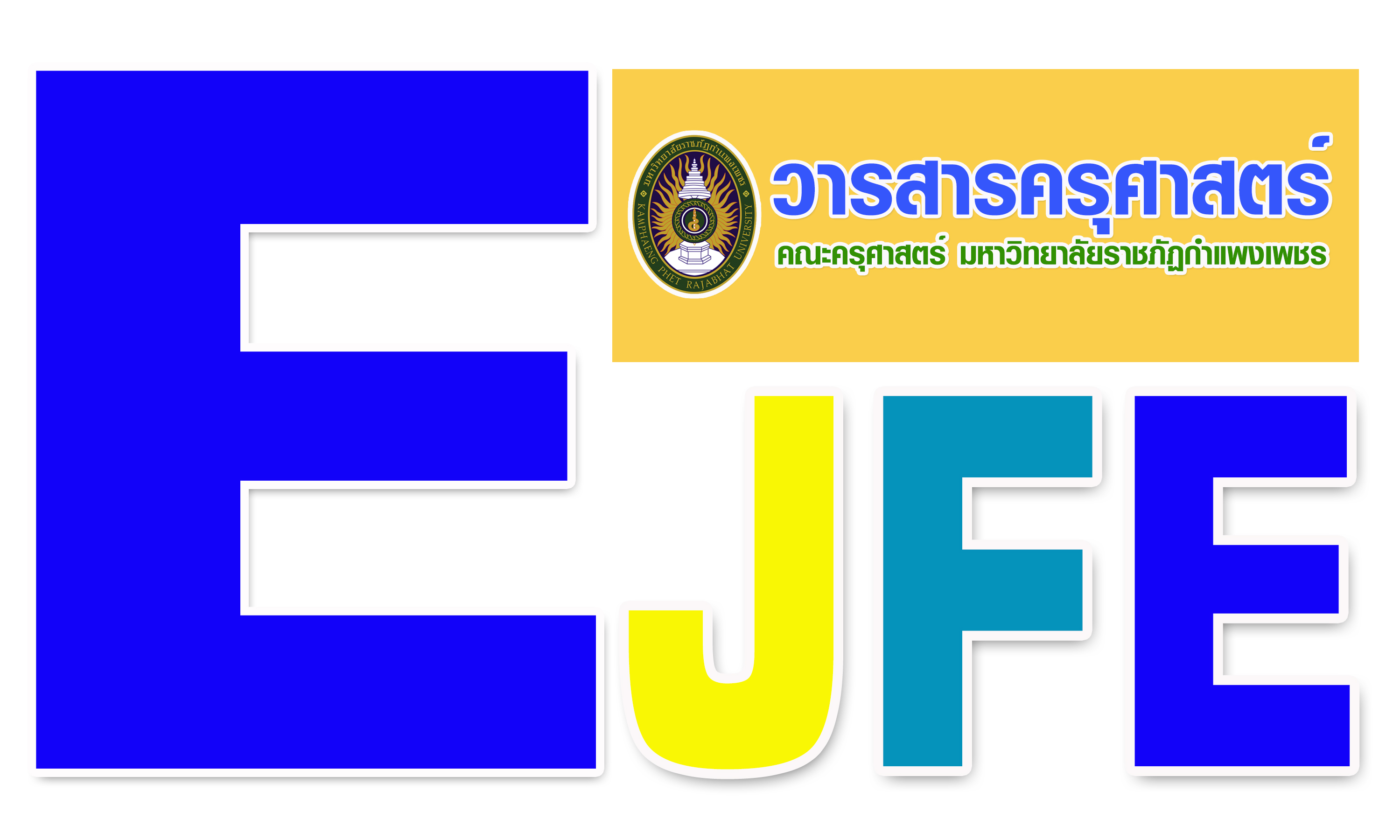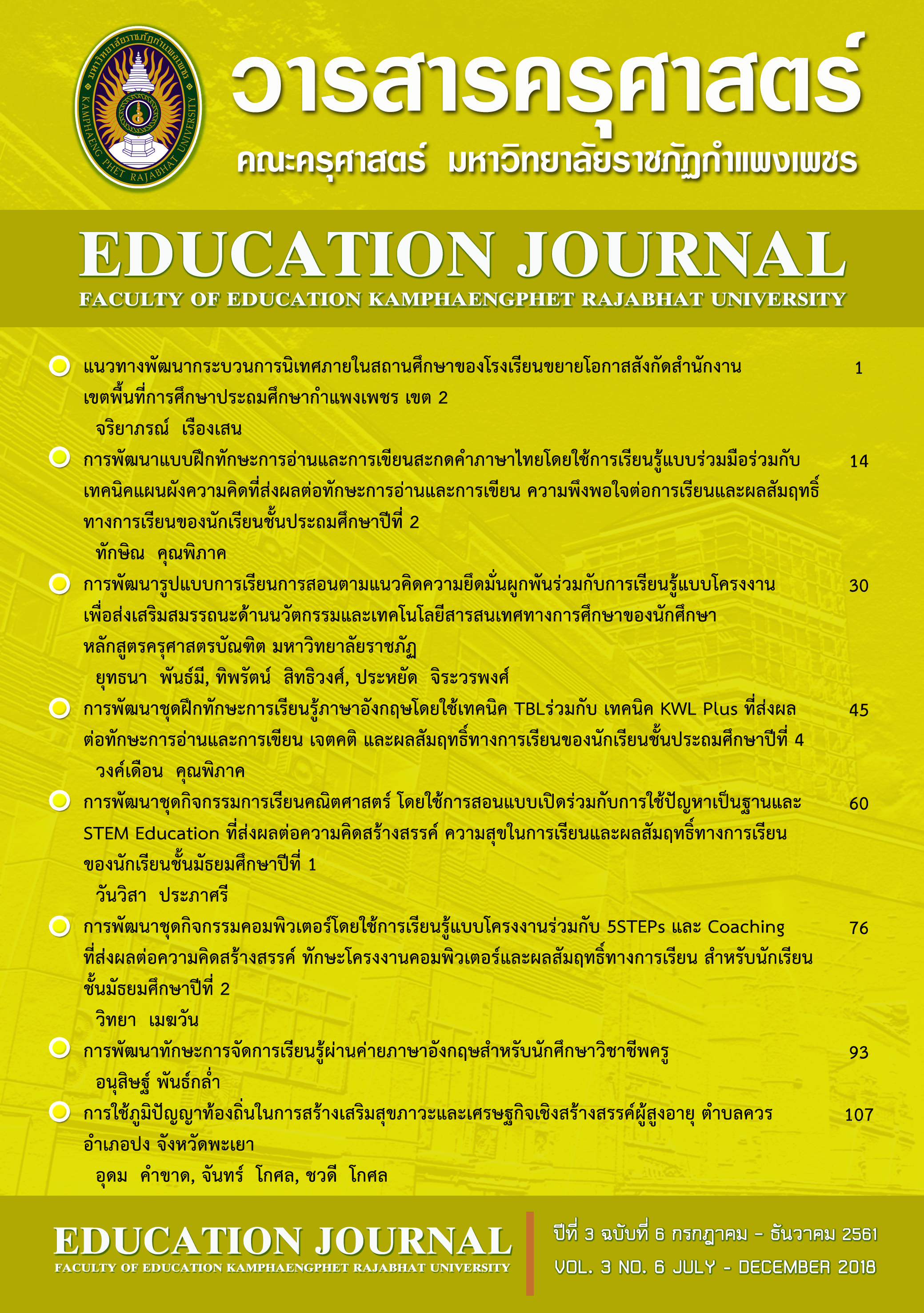DEVELOPMENT OF COMPUTER ACTIVITY PACKAGES BY USING PROJECT BASE LEARNING, FIVE STEPS AND COACHING AFFECTING MATTAYOM SUKSA 2 STUDENTS’ CREATIVITY, SKILLS OF COMPUTER PROJECTS, AND LEARNINGACHIEVEMENT
Main Article Content
Abstract
The purposes of this study were: 1) to develop computer activity packages by using Project Base Learning, 5 STEPs and Coaching to contain the efficiency of 80/80, 2) to compare the students’ creativity possessed before and after learning through the computer activity packages constructed by using Project Base Learning, 5 STEPs and Coaching, 3) to compare the students’ skills of computer projects base on the established efficiency criteria, 4) to compare the students’ learning achievements gained before and after learning through the computer activity packages constructed by using Project Base Learning, 5 STEPs and Coaching, 5) to compare creativity, skills of computer projects, and learning achievement of students whose technological abilities varied (high, moderate and low). The subjects were 28 Mattayomsuksa 2 students who were studying in the second semester of 2017 at BanNatongsaharajutis under the Office of Sakon Nakhon Primary Educational Service Area 1. They were obtained through cluster random sampling. The instruments employed included 1) the computer activity packages constructed by using Project Base Learning, 5 STEPs and Coaching, 2) the test to measure the students’ creativity, 3) the form to examine the students’ skills of computer projects, 4) learning achievement test, 5) the form to assess the students’ technological ability. The statistics employed for data analysis were percentage, mean, standard deviation, E1/E2, t-test (One Samples and Dependent Samples), One-way ANOVA, One-way MANCOVA, and One-way ANCOVA. The study revealed these results: 1. The computer activity packages by using Project Base Learning, 5 STEPs and Coaching contained the efficiency of 83.27/84.57 which was higher than the set criteria of 80/80.
2. After learning through the computer activity packages constructed by using Project Base Learning, 5 STEPs and Coaching, the students’ creativity was significantly higher than that of before at .05 statistical level. 3. After learning through the computer activity packages constructed by using Project Base Learning, 5 STEPs and Coaching, the students’ skills of computer projects were higher than 70 percent. These skills were significantly higher than those of before at .05 statistical level. 4. After learning through the computer activity packages constructed by using Project Base Learning, 5 STEPs and Coaching, the students’ learning achievement was significantly higher than that of before at .05 statistical level. 5. After learning through the computer activity packages constructed by using Project Base Learning, 5 STEPs and Coaching, the students whose technological abilities differed significantly demonstrated different creativity and learning achievement when analyzing the data by using One-way MANCOVA. When employing One-way ANOVA to analyze the students’ creativity and learning achievements, it was found that these variables also significantly varied at .05 statistical levels. When adopting Scheffe to gain post hoc testing, these results were obtained: 5.1 The students whose technological ability was high had significantly higher creativity than those whose technological abilities were moderate and low at .05 statistical levels. 5.2 The students whose technological ability was high had significantly higher skills of computer projects than those whose technological abilities were moderate and low at .05 statistical levels. 5.3 The students whose technological ability was high had significantly higher learning achievement than those whose technological abilities were moderate and low at .05 statistical levels.
Article Details

This work is licensed under a Creative Commons Attribution-NonCommercial 4.0 International License.
CC Attribution-NonCommercial-NoDerivatives 4.0
References
กระทรวงศึกษาธิการ. (2551). หลักสูตรแกนกลางการศึกษาขั้นพื้นฐาน พุทธศักราช 2551. กรุงเทพฯ: โรงพิมพ์ชุมนุมสหกรณ์การเกษตรแห่งประเทศไทย จำกัด.
กระทรวงวิทยาศาสตร์และเทคโนโลยี. (2551). การประยุกต์ใช้เทคโนโลยีสารสนเทศในการเรียน การสอน. กรุงเทพฯ: สำนักงานพัฒนาวิทยาศาสตร์และเทคโนโลยีแห่งชาติ.
คณะครุศาสตร์ จุฬาลงกรณ์มหาวิทยาลัย. (2558). เอกสารประกอบการอบรมหลักสูตรพัฒนาครู คุณภาพโดยใช้กระบวนการสร้างระบบพี่เลี้ยง Coaching and Mentoring. คณะครุศาสตร์ จุฬาลงกรณ์มหาวิทยาลัย.
จริยา กั้ววงษ์. (2555). การเปรียบเทียบผลสัมฤทธิ์ทางการเรียน การวิเคราะห์และการคิด สร้างสรรค์ กลุ่มสาระการเรียนรู้การงานอาชีพและเทคโนโลยี เรื่อง การใช้ ซอฟต์แวร์ประยุกต์ในการทำงานชั้นมัธยมศึกษาปีที่ 2 โดยการใช้ทักษะปฏิบัติ ของเดวีส์และการเรียนรู้แบบโครงงาน. วิทยานิพนธ์การศึกษามหาบัณฑิต, มหาวิทยาลัยมหาสารคาม.
ชนินทร์ทิพย์ ลายพยัคฆ์. (2555). การพัฒนาความคิดสร้างสรรค์ทางวิทยาศาสตร์ด้วย ชุดกิจกรรมโครงงานวิทยาศาสตร์ของนักเรียนชั้นมัธยมศึกษาปีที่ 2 โรงเรียนเมือง นครศรีธรรมราช. วิทยานิพนธ์วิทยาศาสตรมหาบัณฑิต, มหาวิทยาลัยราชภัฏ นครศรีธรรมราช.
ชัยวัฒน์ สุทธิรัตน์. (2553). การจัดการเรียนรู้แนวใหม่. นนทบุรี: สหมิตรพริ้นติ้งแอนด์พับลิสชิ่ง.
ดวงนภา สิงหพันธุ์. (2557). การพัฒนาชุดกิจกรรมการเรียนรู้ตามทฤษฎีคอนสตรัคติวิสต์บน เครือข่ายสังคมออนไลน์ เรื่อง การเขียนโปรแกรมภาษาโลโก สำหรับนักเรียนชั้น มัธยมศึกษาปีที่ 3. วิทยานิพนธ์ครุศาสตรมหาบัณฑิต, มหาวิทยาลัยราชภัฏ รำไพพรรณี.
นิลาวรรณ สิงห์งาม. (2558). การพัฒนาบทเรียนบนเว็บโดยใช้โครงงานเป็นฐานร่วมกับ กระบวนการสอนแบบซินเน็คติกส์ที่ส่งเสริมความคิดสร้างสรรค์ สำหรับนักเรียน ชั้นมัธยมศึกษาปีที่ 3. วิทยานิพนธ์ครุศาสตรมหาบัณฑิต, มหาวิทยาลัยราชภัฏ มหาสารคาม.
เบญญาภา วิไลวรรณ. (2556). การสร้างชุดกิจกรรมเพื่อพัฒนาคิดสร้างสรรค์สำหรับนักเรียน ชั้นมัธยมศึกษาปีที่ 2. วิทยานิพนธ์ศึกษาศาสตรมหาบัณฑิต, มหาวิทยาลัยบูรพา.
พิมพันธ์ เดชะคุปต์ และพเยาว์ ยินดีสุข. (2559). สอนเด็กทำโครงงาน สอนอาจารย์ทำวิจัย ปฎิบัติการในชั้นเรียน (PBL-CAR). กรุงเทพฯ: โรงพิมพ์แห่งจุฬาลงกรณ์ มหาวิทยาลัย.
พรพรรณ เจนกระบวน. (2557). การพัฒนาแผนการจัดการเรียนรู้วิชาคอมพิวเตอร์ 2 โดยใช้ กระบวนการ 5 S ตามทฤษฎีการสร้างองค์ความรู้ด้วยตนเองของนักเรียนชั้น ระดับชั้นมัธยมศึกษาปีที่ 1. วิทยานิพนธ์ศึกษาศาสตรมหาบัณฑิต, มหาวิทยาลัย เทคโนโลยีราชมงคลธัญบุรี.
ภารณี เสนีวงศ์ ณ อยุธยา. (2557). การพัฒนาชุดกิจกรรมโครงงานเพื่อพัฒนาเยาวชน แกนนำสู่ประชาคมอาเซียนโดยใช้กิจกรรม ASEAN Camp ตามกระบวนการ เรียนรู้บันได 5 ขั้น QSCCS สำหรับนักเรียนชั้นมัธยมศึกษาปีที่ 4. เข้าถึงได้จาก http://www.bdc.ac.th/workteacher-detail_2281.
วิชัย วงษ์ใหญ่ และมารุต พัฒผล. (2557). การโค้ชเพื่อการรู้คิด (พิมพ์ครั้งที่ 3). กรุงเทพฯ: จรัลสนิทวงศ์ การพิมพ์.
วิภาดา บรรทุมพร. (2553). ผลการจัดการเรียนรู้แบบโครงงานที่มีต่อการพัฒนา นักเรียน ชั้นมัธยมศึกษาปีที่ 1. วิทยานิพนธ์ศึกษาศาสตรมหาบัณฑิต, มหาวิทยาลัยขอนแก่น.
สุคนธ์ สินธนานนท์. (2553). นวัตกรรมการเรียนการสอนเพื่อพัฒนาคุณภาพของเยาวชน. (พิมพ์ครั้งที่ 2). กรุงเทพฯ: ห้างหุ้นส่วนจำกัด 9119 เทคนิคพริ้นติ้ง.
สุคนธ์ สินธพานนท์ และจินตนา วีรเกียรติสุนทร. (2556). การจัดการเรียนรู้ของครูยุคใหม่สู่ ประชาคมอาเซียน. กรุงเทพฯ : ห้างหุ้นส่วนจำกัด 9119 เทคนิคพริ้นติ้ง.
สำนักงานเลขาธิการสภาการศึกษา กระทรวงศึกษาธิการ. (2550). แนวทางการจัดการเรียนรู้ที่ เน้นผู้เรียนเป็นสำคัญ การจัดการเรียนรู้แบบโครงงาน. กรุงเทพฯ: โรงพิมพ์ชุมนุม สหกรณ์การเกษตรแห่งประเทศไทย จำกัด.
สำนักบริหารงานการมัธยมศึกษาตอนปลาย กระทรวงศึกษาธิการ. (2555). แนวทางการจัดการ เรียนการสอนในโรงเรียนมาตรฐานสากล ฉบับปรับปรุง 2555. กรุงเทพฯ: โรงพิมพ์ ชุมนุมสหกรณ์การเกษตรแห่ง ประเทศไทย จำกัด.
อารี พันธ์มณี. (2557). ฝึกให้คิดเป็น คิดให้สร้างสรรค์ (พิมพ์ครั้งที่ 1). กรุงเทพฯ: โรงพิมพ์แห่ง จุฬาลงกรณ์มหาวิทยาลัย.


